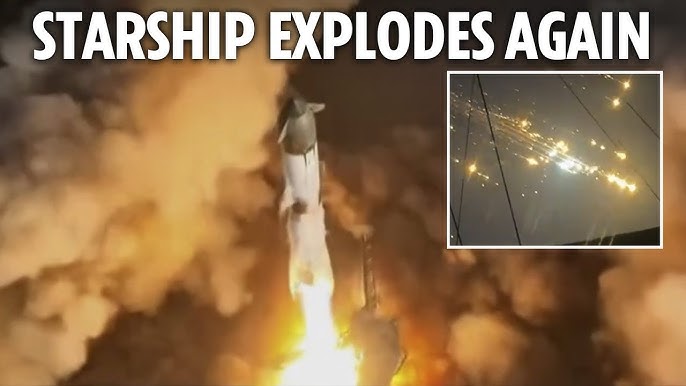The ambitious SpaceX Starship, designed to revolutionize space travel, suffered a spectacular explosion during its eighth test flight on Thursday. The mishap occurred about eight minutes after liftoff from SpaceX’s Boca Chica spaceport in Texas. The explosion was visible from Florida and the Bahamas, with debris causing flight disruptions at several Florida airports.
What Happened?
The Starship took off at 5:30 PM local time (12:30 AM Friday in Poland) and was climbing steadily until disaster struck. Just 30 seconds before its engines were scheduled to shut down, four of the six engines failed, and the spacecraft began to spin uncontrollably at an altitude of approximately 145 kilometers (90 miles). Shortly after, SpaceX lost communication with the vehicle, which then disintegrated in mid-air.
A Firework Show in the Sky
Eyewitnesses described the explosion as looking like “fireworks in the sky.” The Federal Aviation Administration (FAA) grounded flights at four Florida airports for over an hour to avoid potential hazards from falling debris. Although SpaceX assured safety measures were in place, the Caribbean Sea witnessed a dramatic rainfall of Starship fragments.
A Silver Lining: Successful Super Heavy Landing
While the Starship itself met a fiery end, there was a successful outcome. The Super Heavy booster, the first stage of the rocket, executed a perfect landing. It was caught by mechanical arms on the launch tower, marking only the third successful recovery of the booster in SpaceX’s history.
The Lessons Learned
SpaceX acknowledged the setback but maintained a positive tone, stating:
“Today’s flight provided valuable lessons that will help us improve the reliability of Starship. Our team immediately began coordinating with safety officials to implement the emergency plan.”
This test aimed to achieve multiple atmospheric re-entry experiments, including a return of the upper stage to the launch site and a successful recovery of the Super Heavy booster. However, the explosion cut the mission short, leaving critical test objectives unfulfilled.
A Troubled History
This test was supposed to be a redemption mission after a similar failure in January, where the upper stage of the Starship exploded over the Caribbean, showering the Turks and Caicos Islands with fiery debris. That incident prompted a federal investigation, which is still ongoing. The current test was initially scheduled for Monday, but a last-minute “core system” issue led to a postponement.
What’s Next for SpaceX?
The explosion is a setback for SpaceX but also a learning opportunity. With Elon Musk’s ambition of using Starship for interplanetary travel, each test brings the company closer to its long-term goals. For now, the focus will be on analyzing data, improving safety measures, and preparing for the next test flight. As they say in the space industry, “Failure is not the opposite of success; it’s part of success.”
How SpaceX Was Born: The Obama Grants
SpaceX, founded by Elon Musk in 2002, aimed to reduce the cost of space travel and make Mars colonization possible. A pivotal moment came when President Barack Obama awarded SpaceX two grants of $500 million each, providing the financial boost needed to develop the Falcon rockets and support early missions to the International Space Station (ISS). These grants helped transform SpaceX from a bold startup into a key player in the space industry, showcasing the power of public-private partnerships in advancing space exploration.
Stay tuned for more updates as SpaceX continues to push the boundaries of what’s possible in space exploration.





